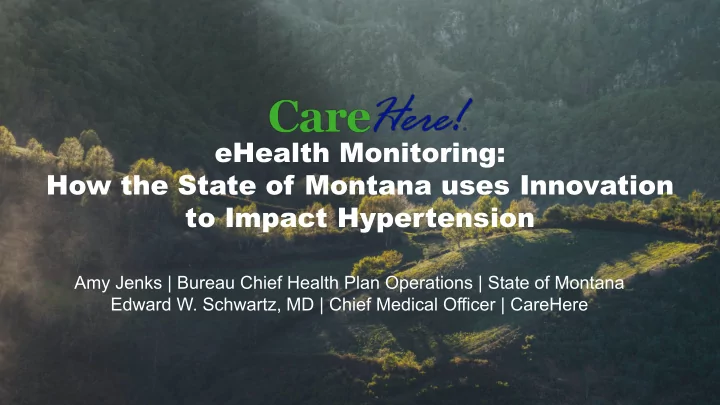

eHealth Monitoring: How the State of Montana uses Innovation to Impact Hypertension Amy Jenks | Bureau Chief Health Plan Operations | State of Montana Edward W. Schwartz, MD | Chief Medical Officer | CareHere
Amy Jenks Bureau Chief, Health Plan Operations State of Montana Amy Jenks is the Bureau Chief of Health Plan Operations for the State of Montana’s Department of Administration Health Care & Benefits Division. In this role, Amy leads a team of professionals in managing the State of Montana Benefit Plan (State Plan) which provides benefits (ie. medical, prescription, dental, vision, life) for State of Montana employees, retirees, legislators, and covered dependents (approx. 30,000 covered lives). Amy has over 20 years’ experience in the employee benefits profession. Prior to joining the State of Montana in 2016 as the Bureau Chief of Operations, she served eighteen years as the Vice President of Operations for the Montana Bankers Association, leading its for profit subsidiary HealthServe in all aspects of self-funded health plan operations, specializing in association health plans. Additionally, Amy is a life, health and property, casualty licensed insurance agent and holds the designation of Certified Insurance Counselor. 2
About the State of Montana The State of Montana works to improve the health and well-being of it’s approximately 30,000 covered lives. In partnership with CareHere, the State currently offers five Health Centers in Helena, Billings, Missoula, Butte, and Anaconda. Additionally, the State offers programs for Annual Health Assessments, remote patient monitoring of Hypertension and numerous health promotion initiatives. 3
Ø In 2010, the State’s Health Care & Benefits Division and Department of Health & Human Services partnered to create a pilot project focused on improving blood pressure control for employees and dependents. This pilot project identified plan members with hypertension and offered them an at-home blood The Problem pressure cuff. Grant funding was available for the project. Ø In 2018, the State of Montana’s grant expired. The Division found the program was of value for members and had to decide how to administer the program going forward. Ø The Division and CareHere came together to design a better solution to improve the health of the State’s hypertensive population. 4
1. Provide a program that educated participants on the risks of hypertension, monitor blood pressure readings, and provide tools to help address abnormal readings. State of Montana Program Goals 2. Use technology to better engage participants in monitoring blood pressure readings. 3. Coordinate care with primary care providers in an effort to better address abnormal readings. 5
What is eHealth Remote Patient Monitoring? ü Programs designed to remotely monitor, intervene, and educate at-risk & chronic patients ü Bluetooth enabled BP cuffs, glucometers, scales, fitbits, and wearables ü Centralized platform to monitor, educate & intervene proactively or from critical health alerts ü Programs targeting: ü Hypertension ü Diabetes ü Obesity* ü Cardiovascular* ü Respiratory* ü Hospital Avoidance* * Denotes programs scheduled for future development 6
eHealth Remote Patient Monitoring: State of Montana Hypertension Program ü Program launched on 7/1/18 ü Program launched for health center populations in Helena, Billings, Missoula, Anaconda & Butte ü Patients enrolled via referral from CareHere provider ü The program currently has 500+ Enrollment patients enrolled Centers 7
eHealth Hypertension Remote Monitoring Program: How it Works Engage Activate Graduate 1) Provider referral 1) Monitoring & Plan 1) BP Trend below 120/80 of Care 2) Self-referral 2) 90 day trend = zero or 2) Up to 9-Month Program minimal improvement timeline 3) Patient attains compliance 4) Patient requests removal 8
Outcomes: Participants vs. Non-Participants 9
Outcomes: Hypertension Stage Movement Moving the needle Hypertension Home Monitoring Program Hypertensive Stages Hypertensive Stages Hypertensive Stage Movement (start of program) (30+ days in the program) Systolic Diastolic 9% 1% 7% 3% 16% 33 4 25 9 27% 57 96 Systolic Systolic 40% 63% 144 60% 42% 150 54% 194 5% 10% 1% 24% 18 34 4 33% 85 26% 24% 28% 91 24% 84 85 Diastolic Diastolic 8% 7% Decreased No Increased Decreased No Increased 36% 46% Stage Change Stage Stage Change Stage 128 164 Normal < 120/80 Stage 1 Prehypertenstion 120/80 - 139/89 Stage 2 Mild Hypertension 140/90 - 159/99 Stage 3 Moderate Hypertenstion 160/100 - 179/109 Stage 4 Severe Hypertension > 180/110 - 139/89
1. Address CareHere staffing needs to ensure program monitoring is done proactively. 2. Create a remote program that allows a State of Montana participant from anywhere in the State with any primary care provider to Program Next Steps participate. 3. Reporting of value. Compare non- participating at-risk population with participating population. 4. Expansion into additional disease states. 11
Th Thank You. Qu Question ons? Am Amy Je Jenks AJenks@m @mt.gov Ed Edward Schwartz, MD ESchwartz@C @CareHere.com 12
Recommend
More recommend